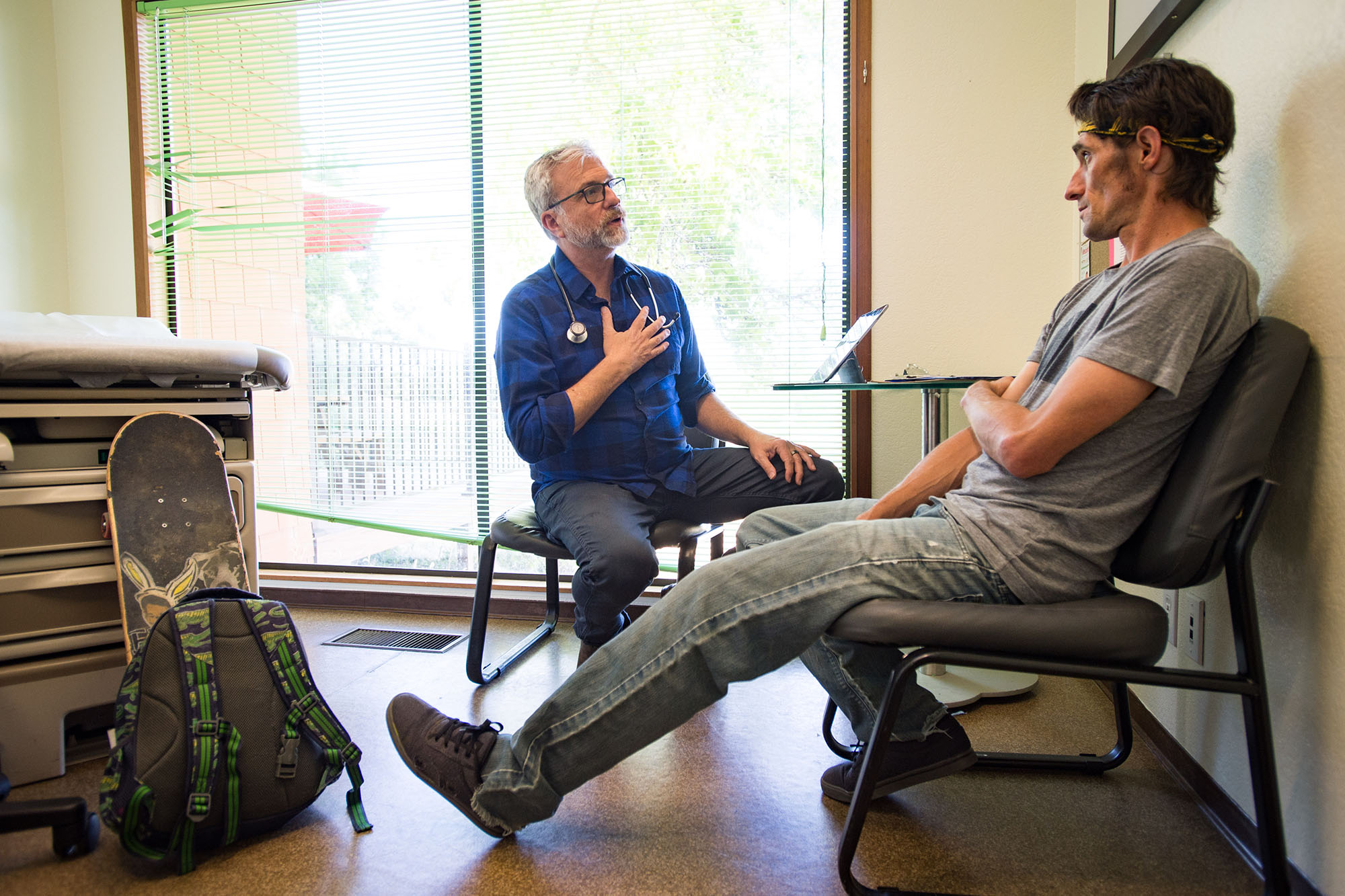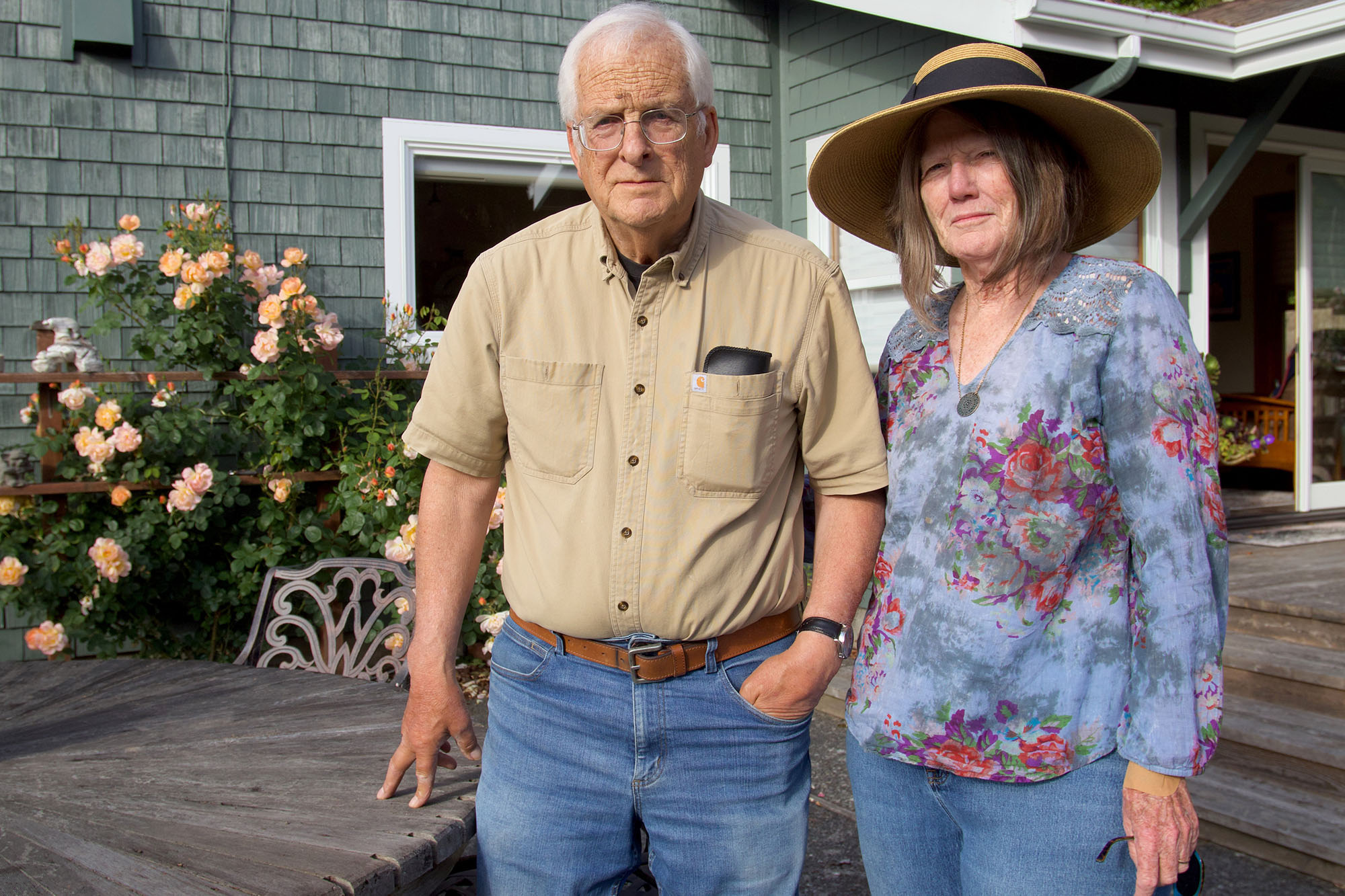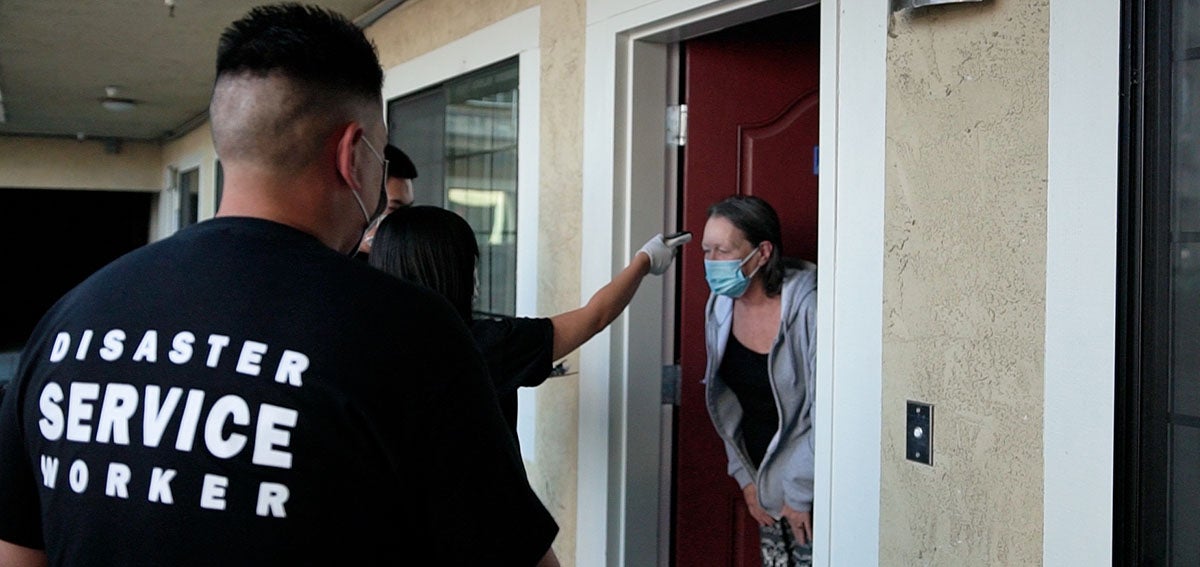
For five years, David’s hammock was his home along San Jose’s Guadalupe River. He previously lived on a boat in the Berkeley Marina until his fibromyalgia and irritable bowel syndrome made him too sick to keep working as a computer network architect and contractor. Unable to pay the docking fees and not wanting to burden his family, he moved into the hammock with two sleeping bags and a foam pad.
“Homelessness beats you up. It’s like you’re a boxer who had a long career,” said David, 43. He averaged eight visits a year to emergency rooms plus more to urgent care centers.
When COVID-19 emerged in early 2020, unhoused people like David in Santa Clara County were assessed and relocated by the county. Those who had contracted or been exposed to COVID-19 or were at high risk for serious illness could shelter at one of 14 hotels leased by the county.
To staff the hotels and emergency shelters, the county reassigned employees as disaster service workers (DSWs). Overnight, the county deployed a diverse corps of public employees, including library warehouse assistants, park staff, probation workers, and many more — and then plunged them into entirely new roles.
Alicia Anderson, senior manager at the county’s Department of Behavioral Health Services, trained DSWs who “did not have a lot of experience working with folks experiencing homelessness.” A weeklong crash course, which she helped design and teach, covered the knowledge and skills for DSWs to work nonjudgmentally with people who might be in crisis. Workers also learned how to try to keep people safe from COVID-19 at a time when there was a scarcity of personal protective equipment and an abundance of fear.
Checking In, with Chronic Illness
Adrian Malimban, who had previously served as a community health worker at Santa Clara Valley Medical Center, worked at one of the hotels with other DSWs, county employees, and community partners to manage day-to-day operations, including temperature checks and medication deliveries. Malimban also identified clients who might need COVID-19 testing or other medical attention, and he would tee up the clinical teams who were regularly on site.
Physicians and health care workers from Santa Clara Valley Medical Center’s Valley Homeless Healthcare Program (VHHP) would attend to COVID-19-related issues at the hotels and shelters as well as unaddressed chronic illnesses and other conditions like heart disease and open wounds.
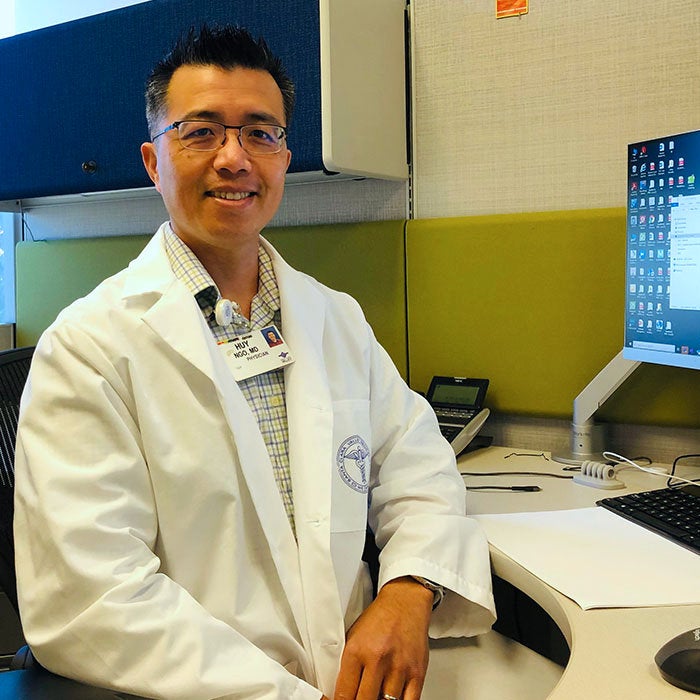
Each client rarely had just one issue. Instead, there were multiple and co-occurring medical and social needs. “They were all complicated situations,” said Huy Ngo, MD, who provided medical care at the hotels. He also works at the Hope Clinic, which provides primary and behavioral health care and social services under the umbrella of VHHP and the County of Santa Clara Health System.
The patients rely heavily on the judgment of DSWs and health care workers. There was the man who had been using methamphetamine, hadn’t slept for three days, and was exhibiting increasing symptoms of paranoia.
“We didn’t want to exit him from the motel. We wanted to keep him safe,” said Malimban, who met with the man several times “to see what I could do, but I was getting nowhere.” Malimban decided to learn more about meth and gain a greater understanding of the client’s background.
“We started building a relationship and trust,” Malimban said. Eventually, the client came to him saying he needed help. Malimban organized the man’s rehab treatment and a housing application, which was ultimately successful.
“Whatever Was Needed”
At an emergency shelter near the motel, county DSW Sudha Kalyan provided on-the-spot counseling. Although some clients who seemed as if they might benefit from behavioral health care declined her offer to see a psychiatrist or psychologist, Kalyan was surprised by how many others welcomed the care.
“People wanted help,” Kalyan said. “People wanted a solution. They were ready to do whatever was needed. They were full of gratitude.”
However, many clients didn’t have a primary care physician or a Medi-Cal card. “Most people had fallen off the map and needed to be hooked back,” said Kalyan. She, Malimban, and other county employees prioritized enrolling or reenrolling them.
Some who were unhoused also benefited from being reconnected to their family, like an elderly man who needed skilled nursing care. He was enrolled in Medi-Cal, but there was a financial issue that needed to be addressed before he could be admitted to a facility.
Kalyan hunted down the files of the client’s former case manager and learned that the man had a son. She phoned him and explained the situation. Although the man didn’t want to reengage with his father, he was happy to cover the financial shortfall.
A 95% Vaccination Rate at the Easy 8
When COVID-19 vaccines became available, Malimban, other DSWs, and health care workers at the VHHP encouraged clients staying at the Easy 8, a county-leased hotel near the San Jose airport, to get the shot. These workers helped vaccinate 80% of the clients, a number that eventually climbed to 95%.
At first, many clients were skeptical and wanted more information. So he and his colleagues created workshops and surprisingly popular crossword puzzles with good information about vaccines. They also frequently met with clients to answer questions and coordinate on-site vaccines.
“I called a nurse I knew at the hospital, and she brought a mobile van and did a mass vaccination,” said Malimban.
Now that the overwhelming majority of clients have been successfully protected from COVID-19, the county looked to the future. There were widespread concerns that when the program wound down, it might hurt clients who were gaining stability and making headway on their health.
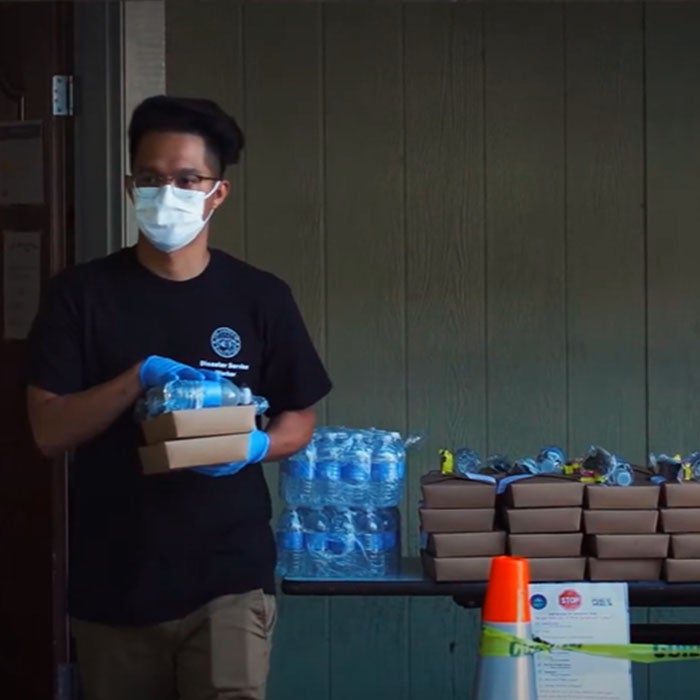
“We didn’t want to exit people back to the streets. We wanted them to be in safer positions in their lives,” said Malimban.
With new interim and permanent housing being built thanks to federal and state pandemic-related funds, rare housing opportunities opened up. For clients to be considered for such housing, Malimban, Kalyan, and others urgently completed the necessary paperwork. The speed required to accomplish this while also juggling clients’ other needs matched well with what Malimban called the county’s “foot-on-the-pedal culture.”
“Thousands of people were homeless when we first started at the hotels,” Malimban said. “Now many of them are in permanent housing. People could have been dead on the streets.”
Staff at the hotels and shelters also advocated for critical social services that clients sought, such as food stamps and disability income. They leveraged existing relationships and built new ones with employees across a maze of local agencies and community-based organizations.
“Everyone working across disciplines and departments was like a dream come true in the most unideal of circumstances,” said Anderson.
As a result, “clients who had been lost on the streets were finally connected to the county system,” said Malimban. Since then, a majority have received more care and services than before the virus emerged in California.
Preserving Momentum
“We can do these things” is a key lesson learned during the pandemic, Ngo said.
Now, as the hotel and shelter program winds down to three hotels, and as clients transition to housing, family, or back to streets and parks, many county officials are examining how to build on its success.
“There’s such great momentum during this time. The fear is, we don’t want to lose that,” Ngo said. “We want to keep that open mindset, continue to communicate, and bridge people and programs while keeping our expectations and quality high.”
He believes burnout is the primary obstacle to building on what he called “this new standard that we set. Staff has been stretched super thin for so long,” he said.
“Moving forward, we need to have more resources devoted to the various programs serving the homeless community, because sometimes the need is more,” Ngo said.
An impressive 5,200 people were permanently housed between January 2020 and September 2021. Today, most of them have connected with services, and they’ve been seeking care at the Hope Clinic in growing numbers. Ngo has added providers and extended hours to keep up with increased demand.
David, the network architect, is one of Ngo’s patients. Thanks to the Hope Clinic, he quit his hammock and moved into an apartment with easy access to medical care and social services. Today, he describes his once ravaged health as “very good.”
An increasing number of people need the same type of housing and integrated care that David receives.
This article was adapted from one first published by the California Association of Public Hospitals and Health Systems (CAPH) on December 14, 2021, and it is reproduced with permission of CAPH and the author. Copyright 2021, all rights reserved.
This is one of a series of CAPH blog articles funded by the California Health Care Foundation.
Authors & Contributors

Aisling Carroll
Aisling Carroll is a Bay Area–based freelance writer and former journalist who covers health care, digital health, hospitals, and the patient-doctor relationship. Her work has been published in Stat News, HuffPost, Business Insider, Congressional Quarterly, and others. Carroll received a bachelor’s degree in political science from UC San Diego.

